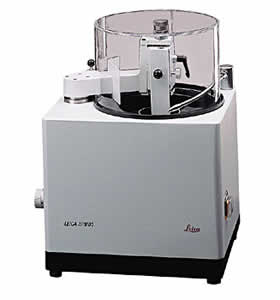Leica SP1600 Saw Microtome
Leica Updated: 2009-02-07 RSS
The Leica SP1600 saw microtome is specially designed for the cutting of extremely hard and brittle industrial materials embedded in methylmetacrylate with a maximum size of 35 mm in diameter. Materials such as steel, titanium or bioceramics cause no problems in the preparation with the Leica SP1600 Saw Microtome.
Key Features
* Works with different critical materials ranging from decalcified or undecalcified bone with implants embedded in methyl methacrylate, teeth, mineralogical samples to all kinds of industrial materials
* Specimen size: from 6 to 30 mm in diameter
* Rotating diamond-coated saw blade
* Minimum section thickness: 30 µm
* Specimen feed adjustable in 10-µm increments
* Water-cooled saw blade
Slices of very hard materials can be prepared without destroying the morphology of the specimens for investigation using light microscopy. Section thicknesses of approximately 30 µm can be achieved under optimum conditions. Specimen advance - The heart of the microtome is a diamond-coated inner-hole saw blade. To prepare a section, the object holder is guided slowly towards the rotating cutting edge of the saw blade. Compared to the sectioning principle, the sawing method causes less compression. With the sectioning technique serial sections can be produced, as opposed to the sawing technique in which the user has to calculate the loss of material caused by the thickness of the diamond-coated saw blade. The speed of the rotating blade is approximately 600 rpm. The built-in water cooling device prevents the object from overheating and removes saw-dust from the cutting edge.
Specimen preparation - The object can be mounted into the object holder. The height of the object has to be adjusted until the surface of the object is slightly above the upper edge of the saw blade. The surface of the block has to be trimmed which involves a plane surface being cut prior to producing slices of a defined thickness. During the sawing process, the water flow has to be adjusted so that the water jet lands on the edge of the saw blade.
After trimming, the first undefined slice can be removed from the saw blade. Now the desired section thickness can be selected, taking into consideration that the thickness of the saw blade has to be added to the desired thickness of final section. When preparing very thin sections of about 20-30 µm, it is recommended to stabilize the section during the sawing process. To do so, a glass cover slip can be glued onto the trimmed surface of the specimen block using cyanoacrylate glue.
User Manual
Related Manuals
Leica SM2010 R Sliding Microtome
Leica SP2600 Ultramiller
Leica LN22 Nitrogen Freezing Device
Leica VT1000 S Vibrating Blade Microtome
Leica VT1200 Vibrating Blade Microtome
Leica VT1200 S Vibrating Blade Microtome
Leica Q550 IW General Imaging Workstation
Leica Q550 MW Materials Workstation
Leica AF6000 E Entry Level Fluorescence Microscope
Leica AF6000 Advanced Fluorescence Imaging System
Leica AF6500 Fluorescence Station
Leica AF7000 Dedicated Fluorescence Live Cell Station